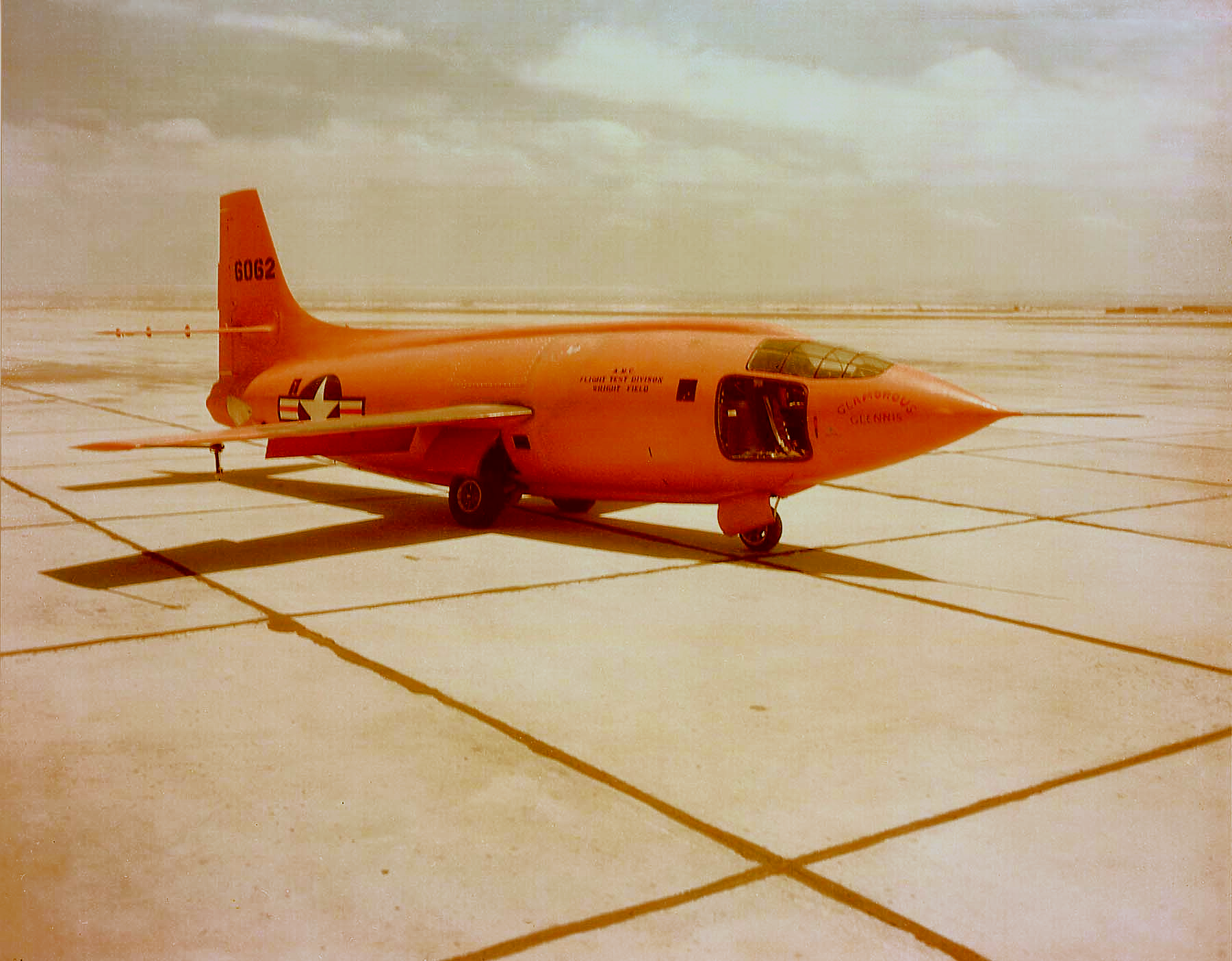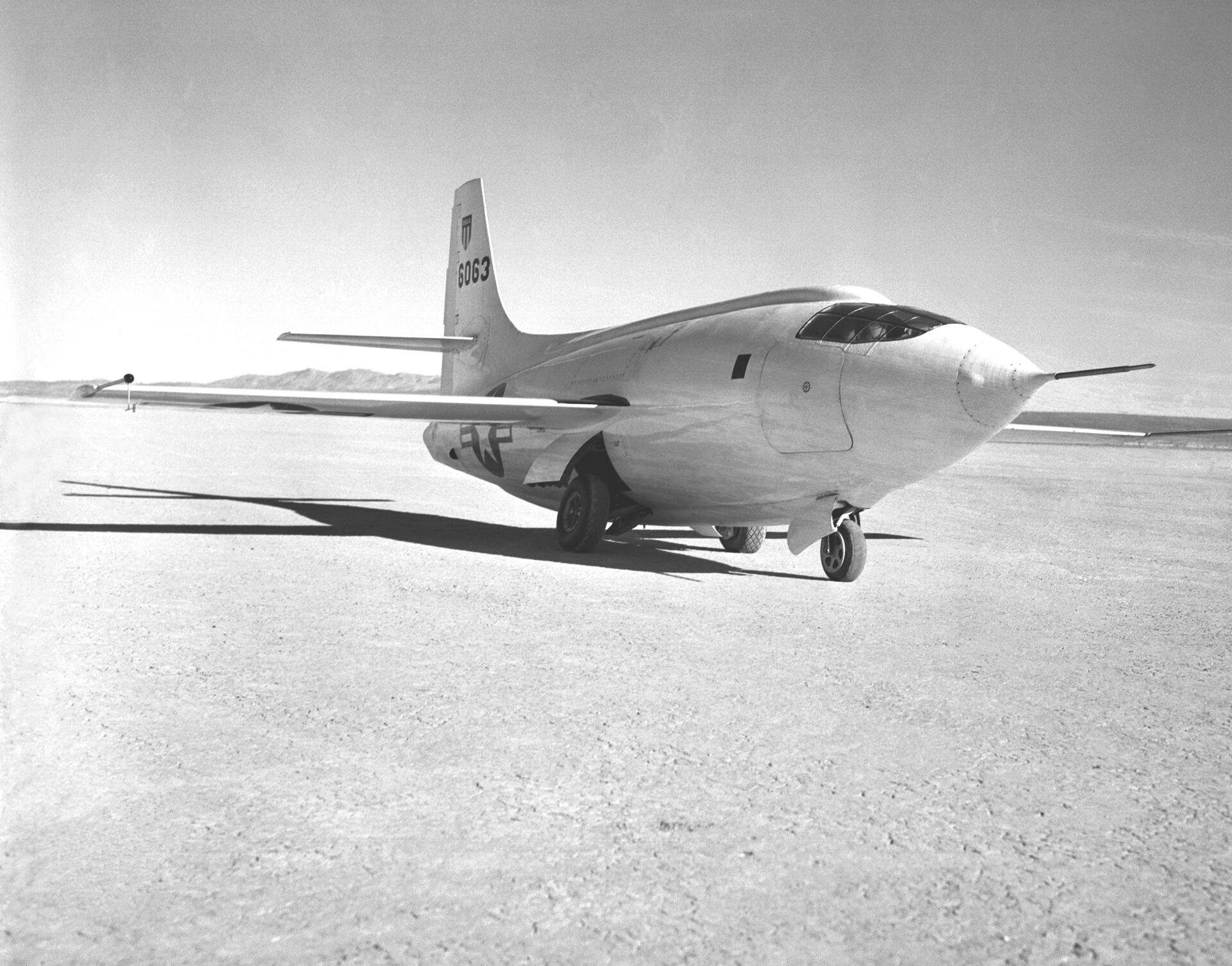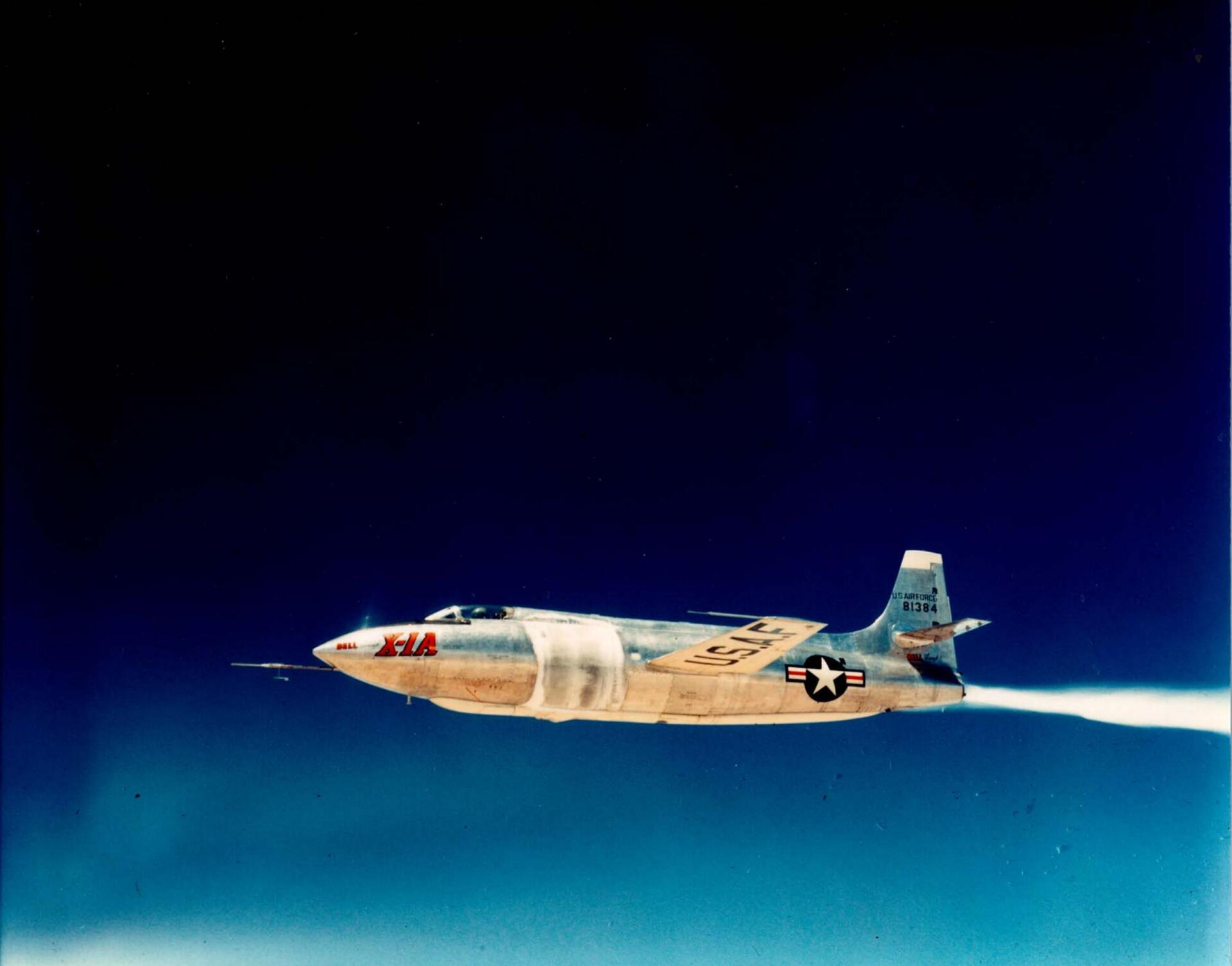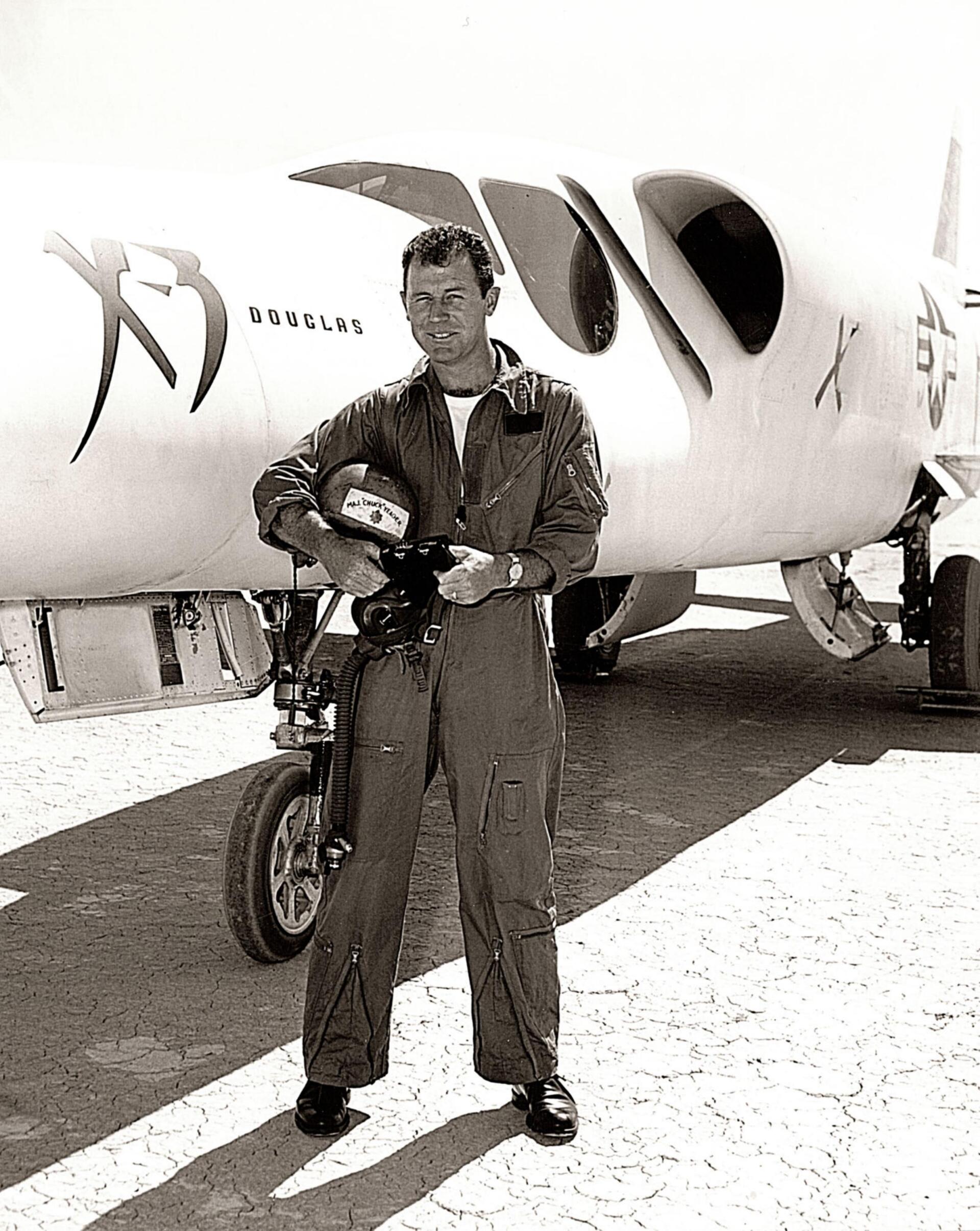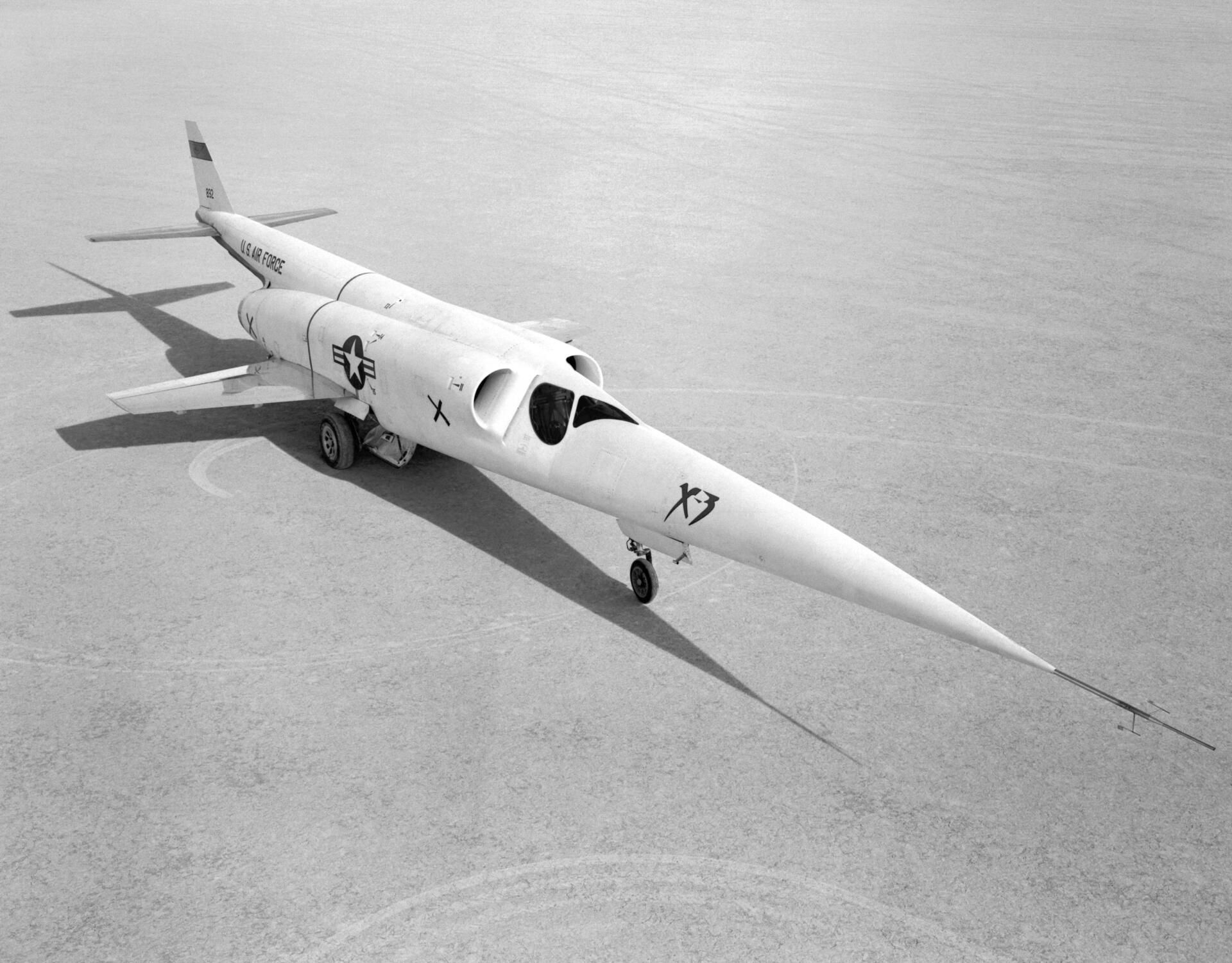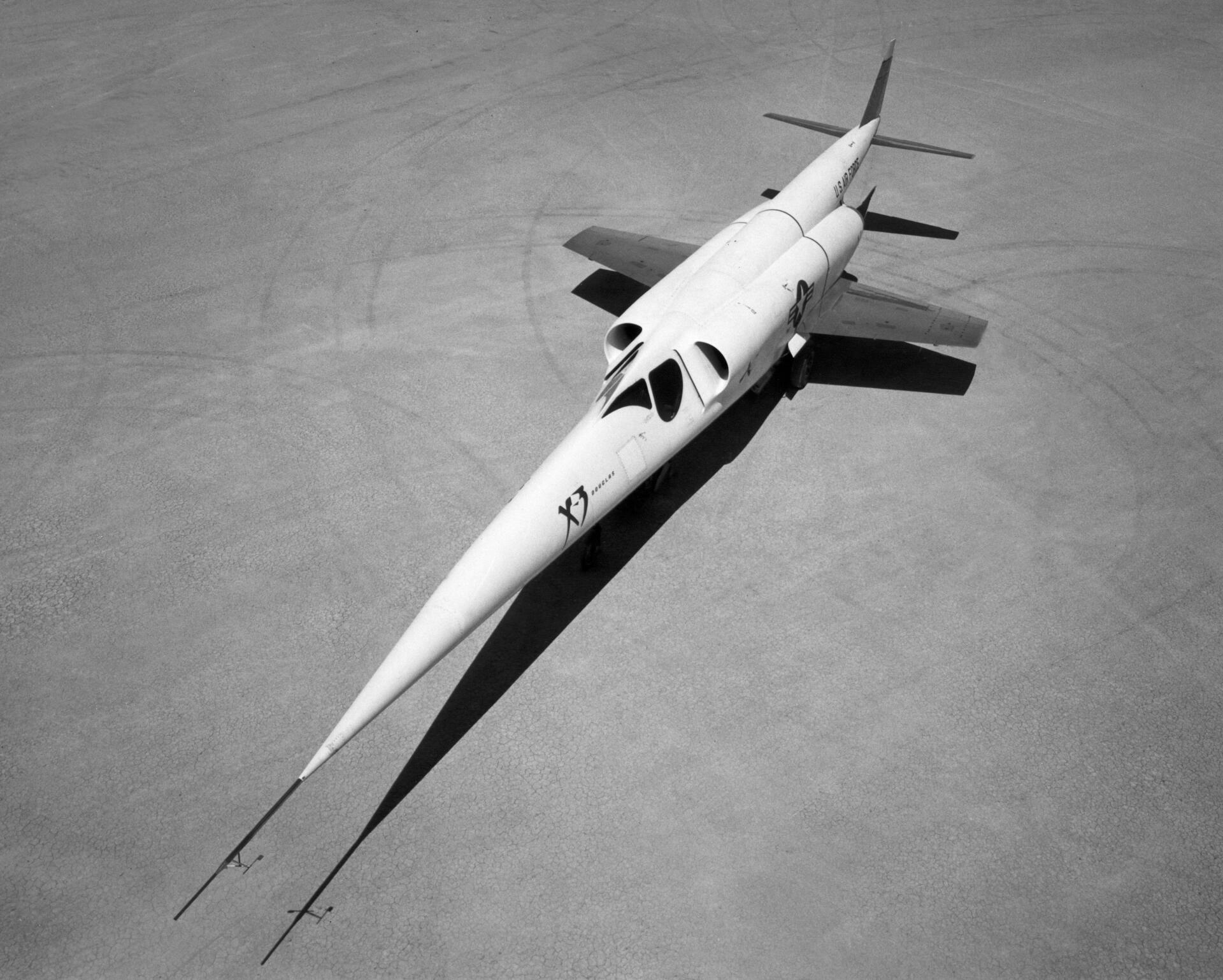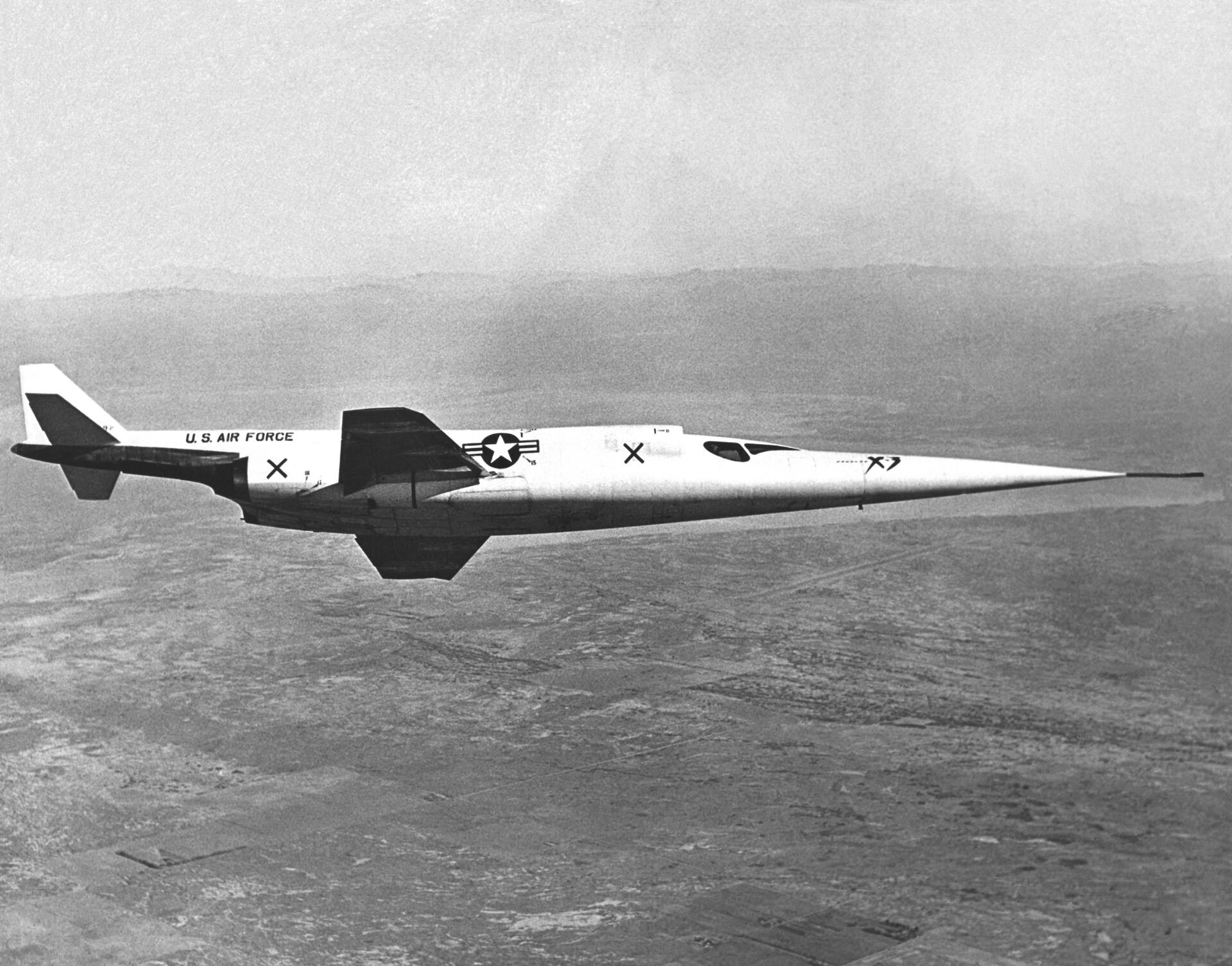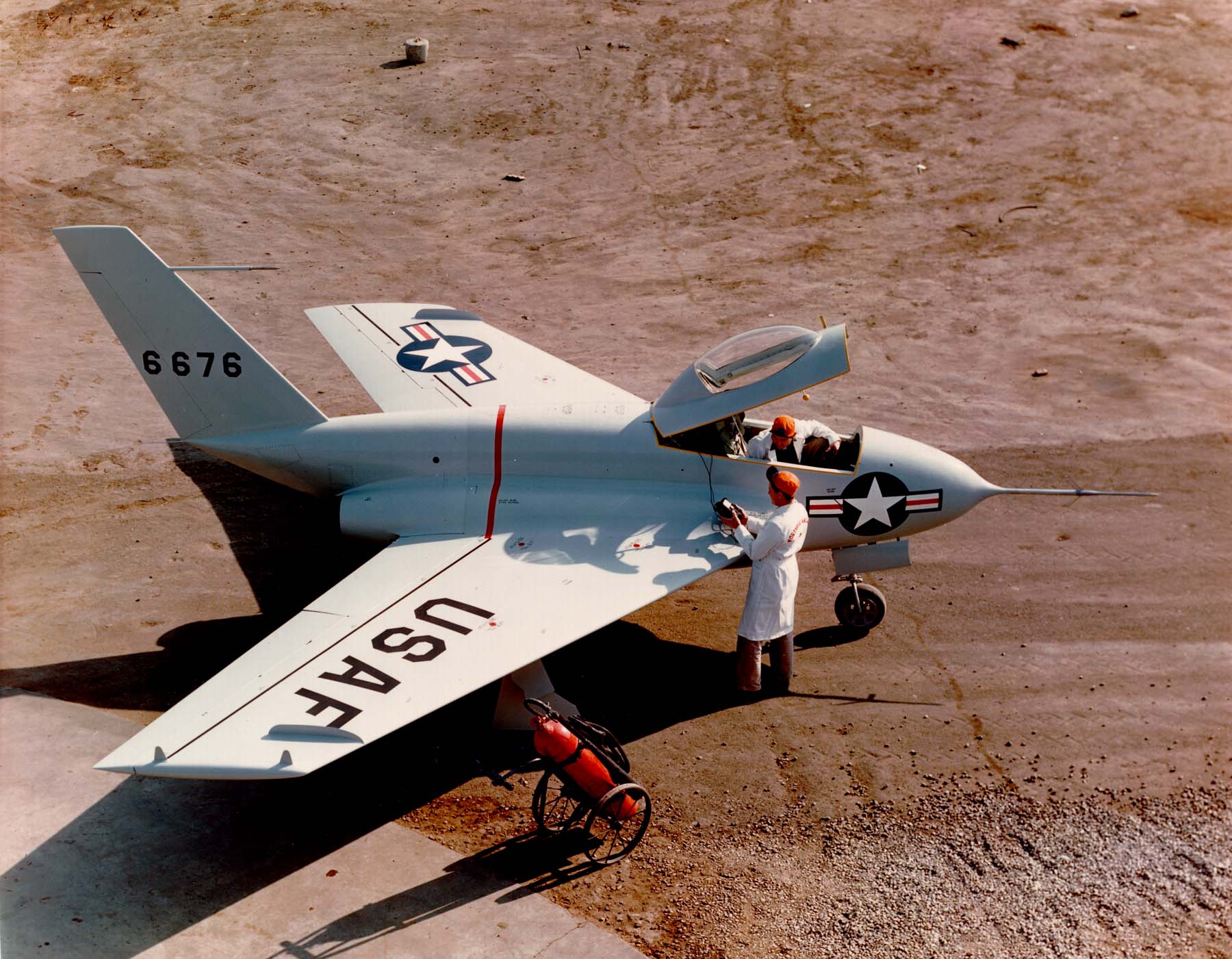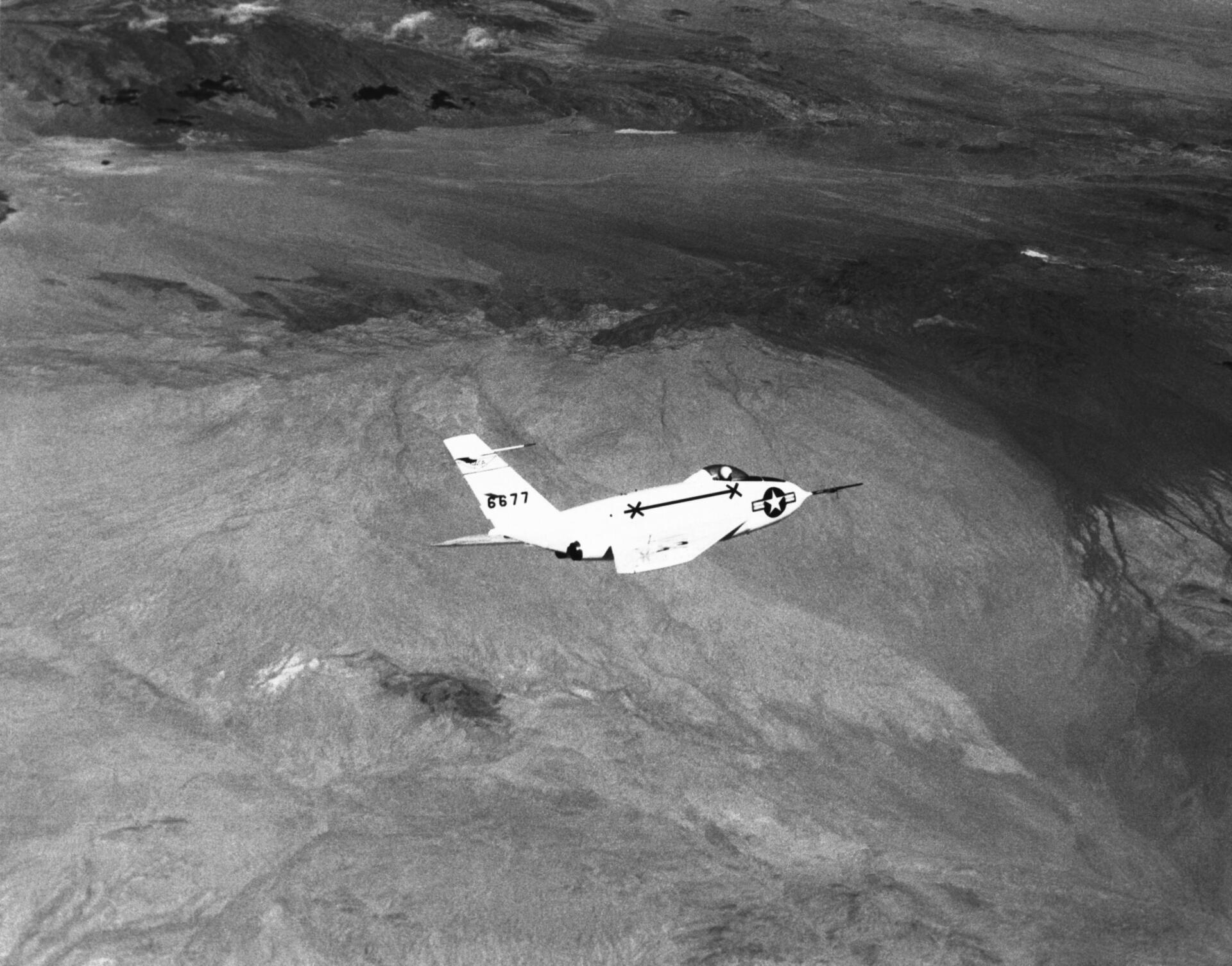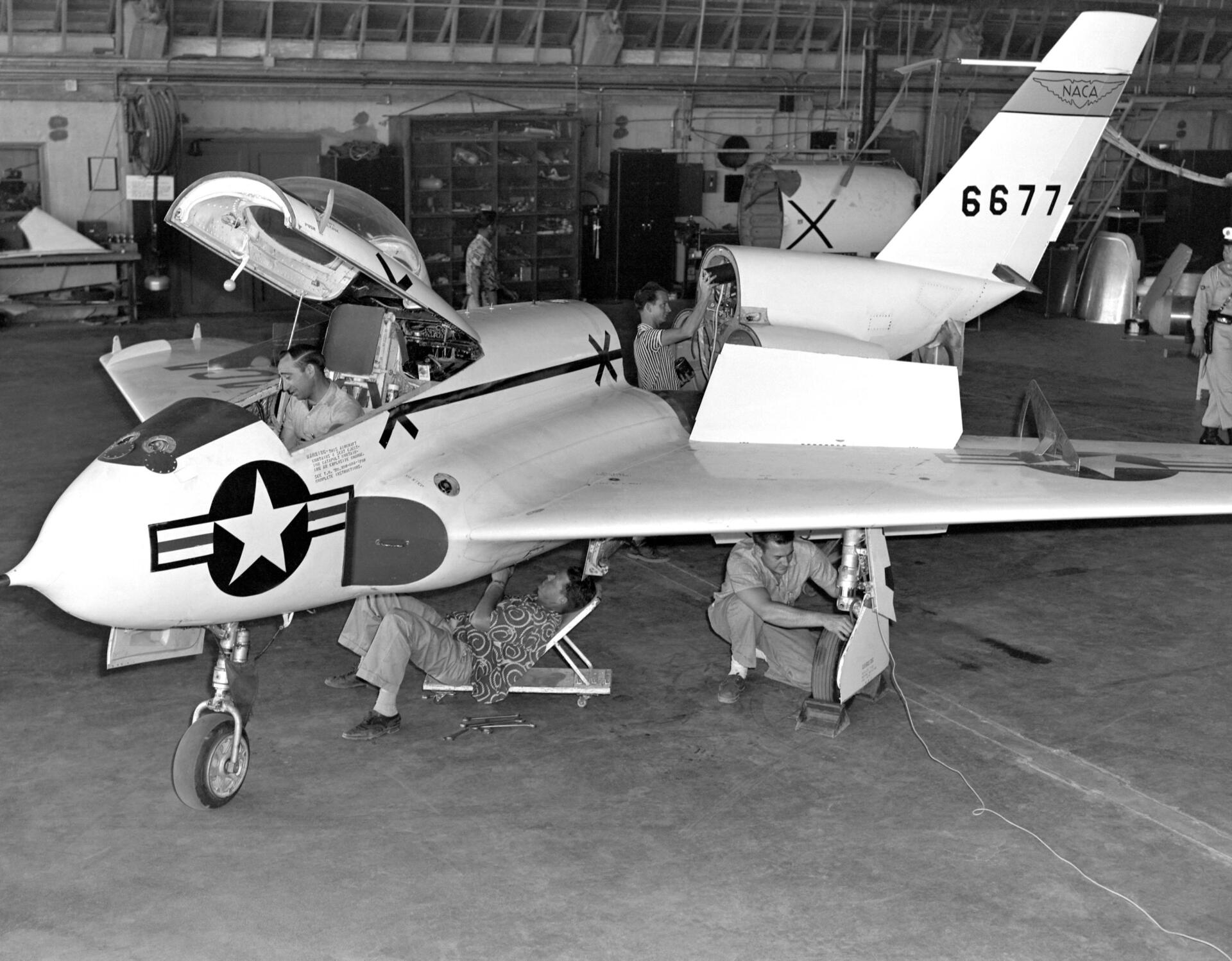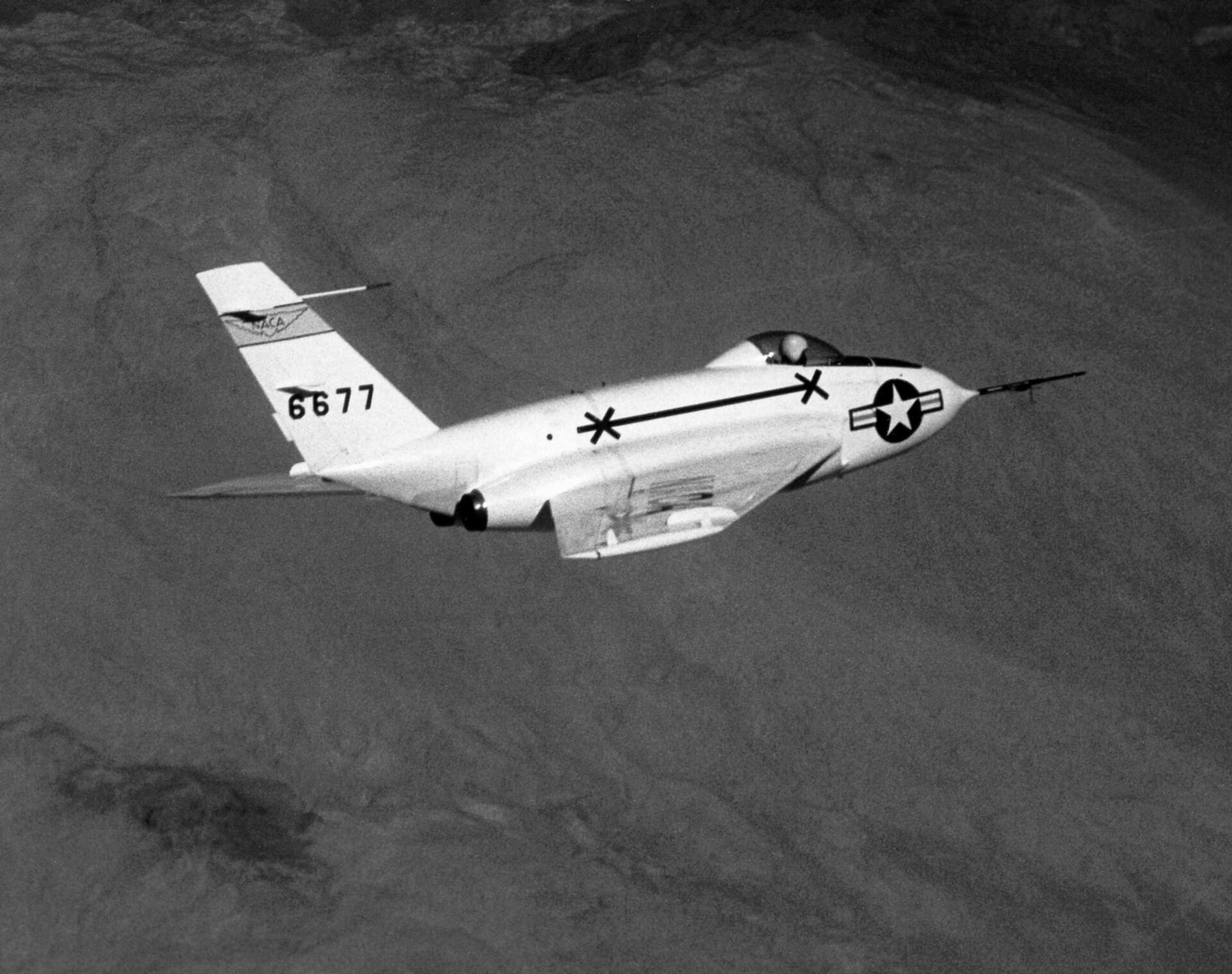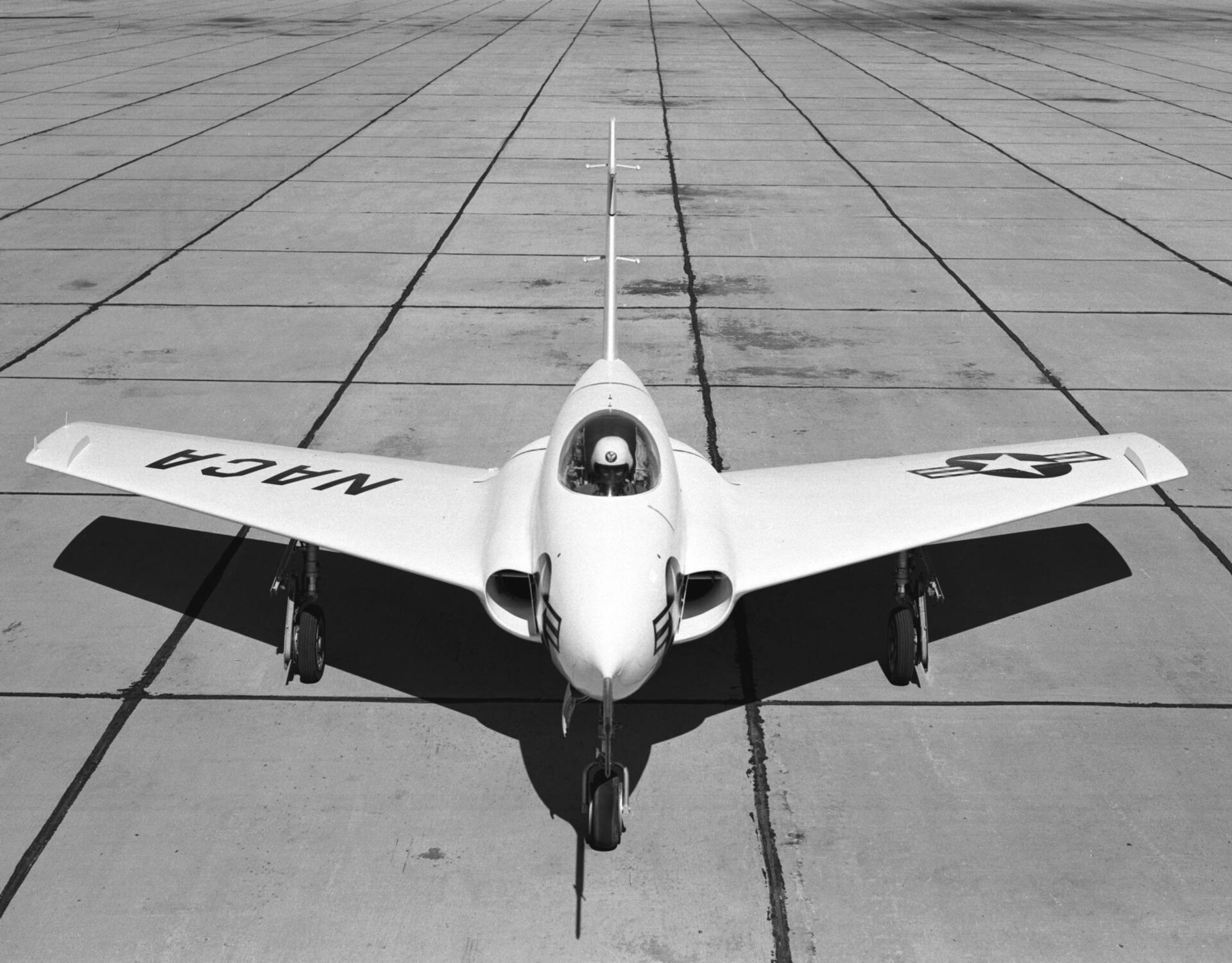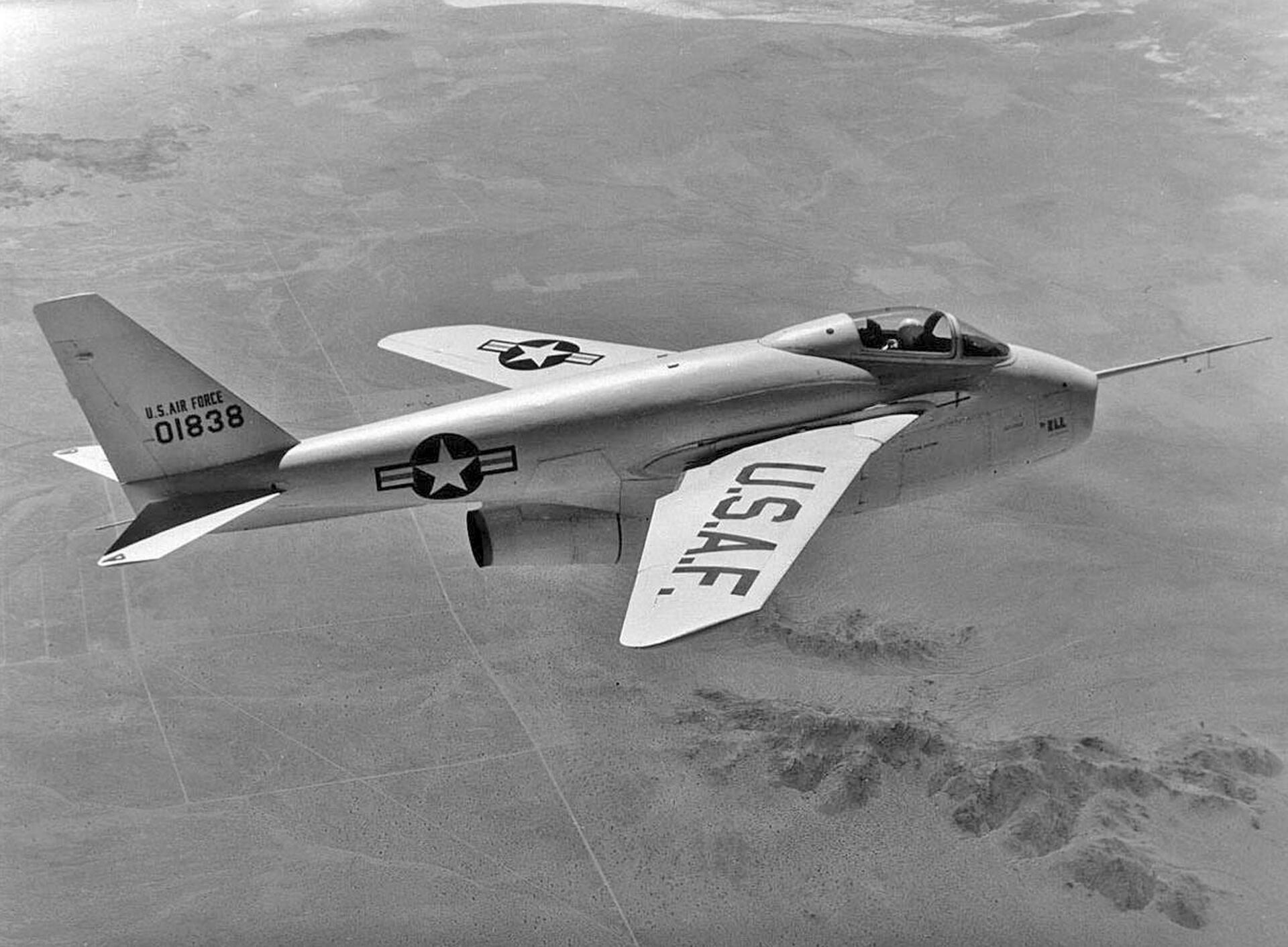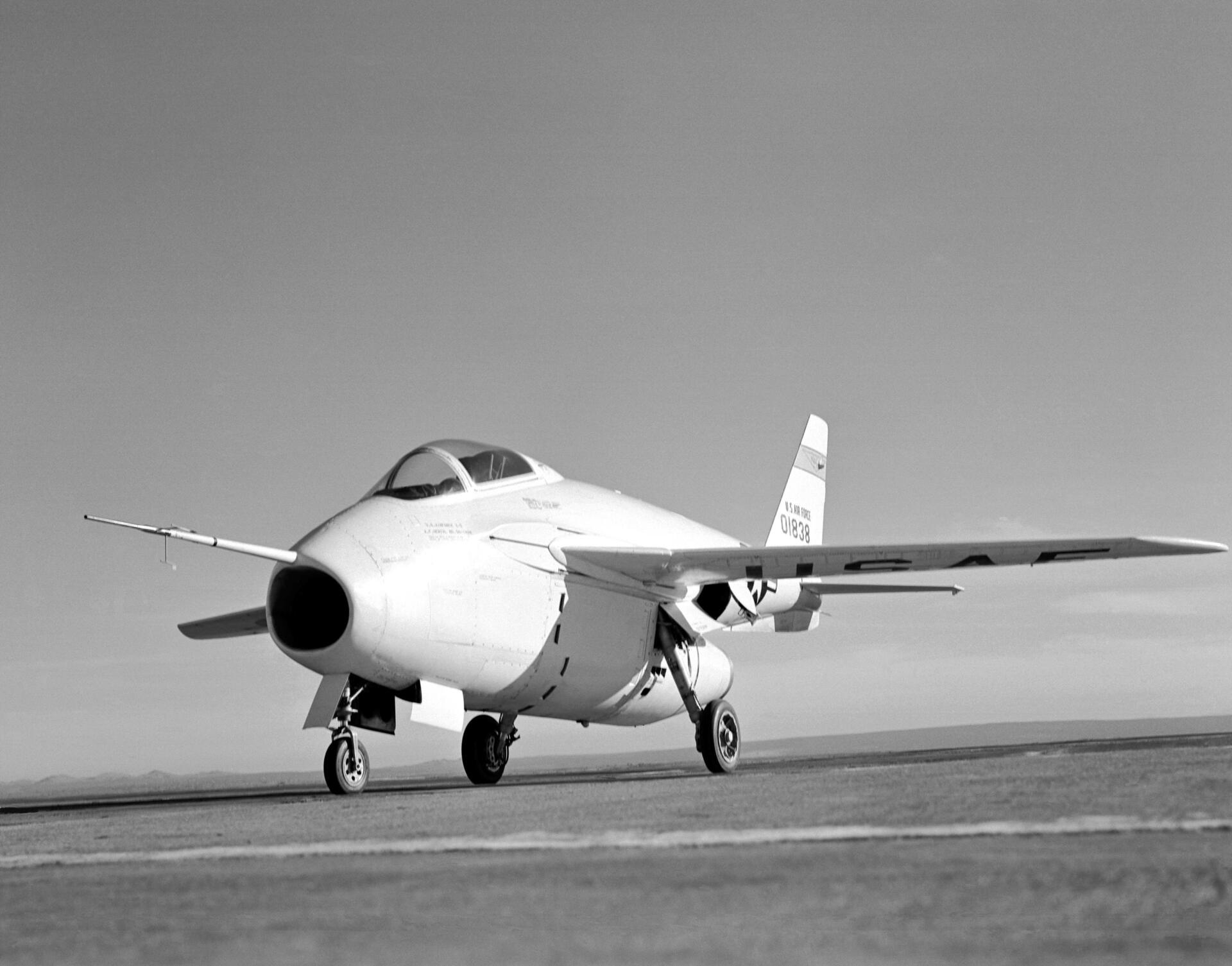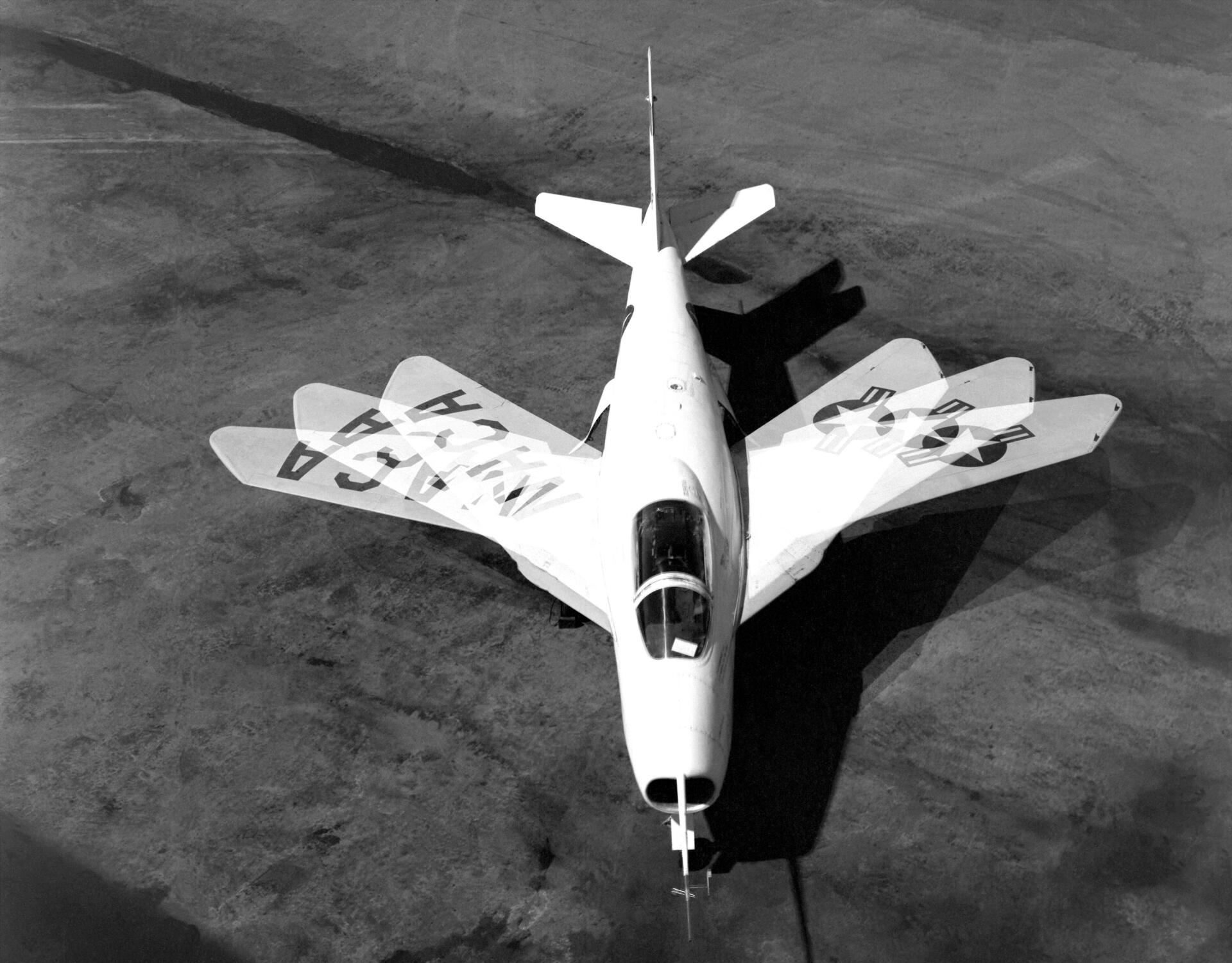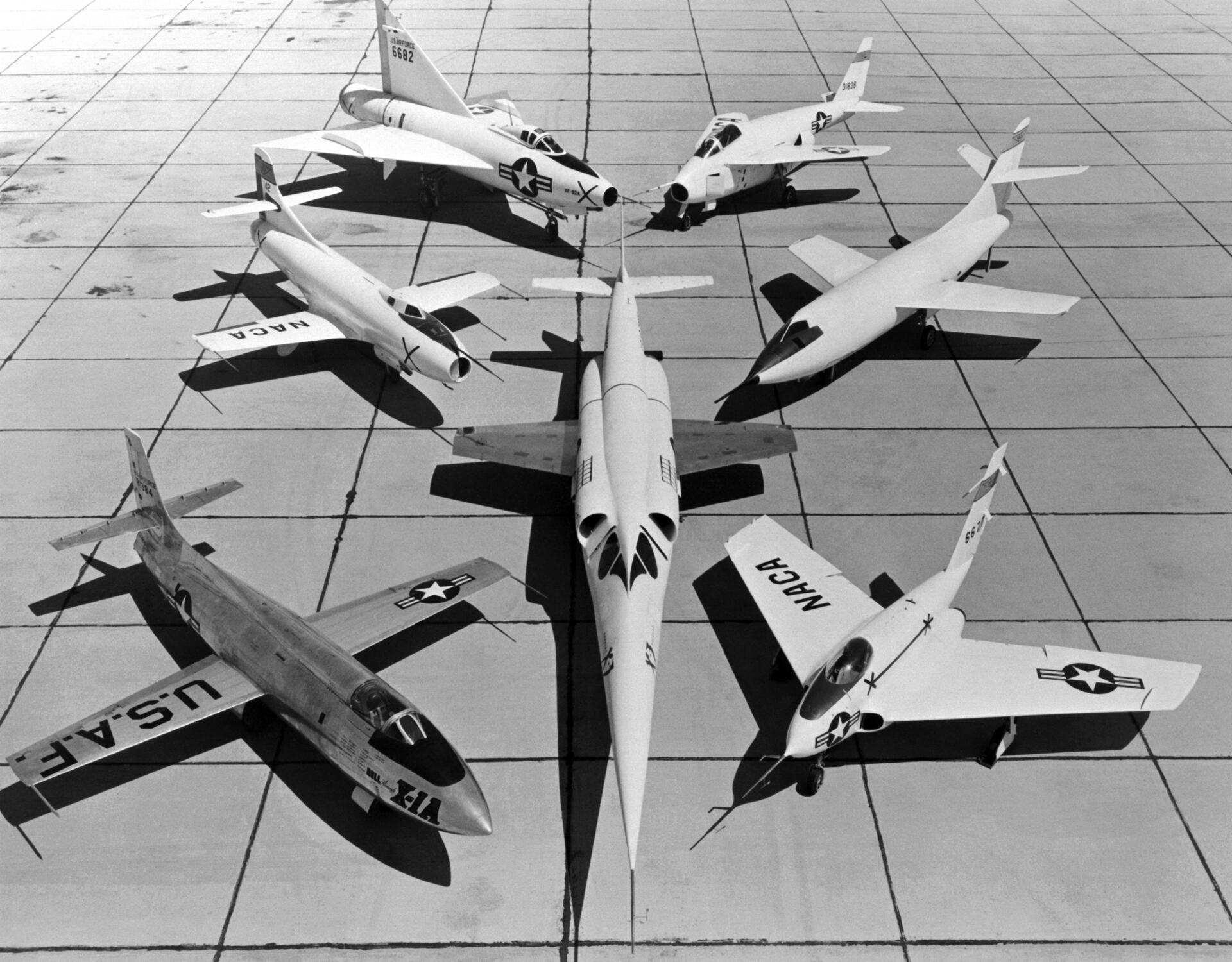The X-Planes Yeager flew
The above is a slideshow of photographs of the various X-Planes featured on this page.
X-Planes
The X (X for experimental) series of airplanes started with the Bell XS-1 (S for supersonic). Various aircraft corporations were invited to put in their bid for the contract and the contract was awarded to the Bell Aircraft Corporation.
Here I hope to enlighten those who are interested in these true pioneering experimental aircraft. The aircraft that are covered by this page include the Bell X-1/X-1A, Douglas X-3 Stiletto, Northrop X-4 Bantam & Bell X-5. All these aircraft were flown by Chuck Yeager. I have also completed a page on the Convair XF-92A ; America's first experimental delta-winged jet powered aircraft.
Bell X-1
The official X-1 contract was signed on March 16th, 1945. The X-1 was designed to investigate the dynamic flight characteristics of flying at or greater than sonic velocities. The prime goals of the program were to safely explore the transonic speed envelope from subsonic (Mach 0.75) to supersonic (Mach 1.3) and to find out the effects supersonic flight would have on stability & control. Three aircraft were ordered and built under the contract, the serial numbers for the aircraft were 46-062 (#1 aircraft), 46-063 (#2 aircraft), 46-064 (#3 aircraft).
The Bell design and engineering team included Paul Emmons, Benson Hamlin, Roy Sandstrom & Stanley Smith (who would later become project engineer).
The X-1's first free flight was in the hands of company test pilot Jack Woolams on January 25th 1946 and was in the #1 aircraft. Woolams flew the aircraft a total of 10 times (all unpowered glide flights) from Pinecastle AFB, Florida. Chalmers H "Slick" Goodlin took over the test programme after Woolams tragic death on August 30th 1946 flying a race configured Bell P-39.
Goodlin's first unpowered flight was on October 11th 1946 at Muroc AFB, California. After a further 3 glide flights, the first powered flight of the X-1 programme was made on December 9th 1946 in the #2 aircraft. The #1 aircraft was returned to Bell's Buffallo plant for modifications. Goodlin made another 11 flights in the #2 aircraft before flying the newly modified #1 aircraft. The modifications to the #1 aircraft included new wings (8% thickness/cord ratio as opposed to 10% thickness/cord ratio of the #2 aircraft) and a new horizontal stabilizer (6% thickness/cord ratio as opposed to 8% thickness/cord ratio of the #2 aircraft). Goodlin's first flight in the modified #1 aircraft was April 10th 1947. Before the #1 aircraft was handed over to the airforce for its accelerated programme, company test pilot Alvin "Tex" Johnston made one powered flight on May 22nd 1947.
The Airforce takes over the programme
Captain Charles E "Chuck" Yeager took over the flight testing for the United States Army Air Force (soon to become the USAF) and made his first unpowered glide flight on August 6th 1947, after 2 more glide flight's, the airforce's first powered flight was made on August 29th 1947. The maximum speed achieved on this flight was Mach 0.85 or approx 570mph. A further 8 powered flights were made before the worlds first piloted supersonic flight was made on October 14th 1947. The X-1 would go on to achieve a maximum speed of Mach 1.45 or 957mph on March 26th 1948 in the hands of Chuck Yeager. The highest altitude achieved was 71902 feet by Major Frank Everest on July 25th 1949.
The #3 X-1 made only 1 glide flight in the hands of Bell test pilot Joe Cannon on July 20th 1951. The #3 X-1 was lost on November 9th 1951, a fire started burning in the "Ulmer Leather" gasket in the rocket engine, this caused an explosion which destroyed both the X-1 and the Boeing B-50 mother ship. The aircraft had just completed a successful captive flight and was in the process of being de-fuelled. Cannon suffered from severe burns, but recovered to fly again.
The #1 X-1 now hangs in the Milestones Of Flight Gallery at the National Air & Space Museum (NASM) in Washington. The #2 X-1 was modified by Bell for the NACA and became the Bell X-1E, this aircraft is on display in front of NASA's Dryden Flight Research Center (now Armstrong Flight Research Center) at Edwards AFB, California.
Below are listed all pilot's and the agencies they flew for with date of first flight and total number of flights made in the original X-1 series. The list is in chronological order.
- Jack Woolams (Bell), January 25th 1946 - 10 flights.
- Chalmers Goodlin (Bell), October 11th 1946 - 26 flights.
- Alvin Johnston (Bell), May 22nd 1947 - 1 flight.
- Chuck Yeager (USAF), August 6th 1947 - 34 flights.
- Herbert Hoover (NACA), October 21st 1947 - 14 flights.
- Howard Lilly (NACA), January 9th 1948 - 6 flights.
- James Fitzgerald (USAF), February 24th 1948 - 7 flights.
- Gustav Lundquist (USAF), April 7th 1948 - 6 flights.
- Robert Champine (NACA), November 23rd 1948 - 13 flights.
- Jack Ridley (USAF), March 11th 1949 - 5 flights.
- Albert Boyd (USAF), March 16th 1949 - 1 flight.
- Frank Everest (USAF), March 21st 1949 - 10 flights.
- John Griffith (NACA), September 23rd 1949 - 9 flights.
- Patrick Fleming (USAF), October 6th 1949 - 1 flight.
- Richard Johnson (USAF), October 26th 1949 - 1 flight.
- Fred Ascani (USAF), May 10th 1950 - 1 flight.
- Scott Crossfield (NACA), April 20th 1951 - 10 flights.
- Joseph Cannon (Bell), July 24th 1951 - 1 flight.
- Joseph Walker (NACA), October 23rd 1951 - 2 flights.
Total number of flights in original X-1 series - 158.
X-1 Second Generation
On the 14th November 1947, exactly one month after Captain Chuck Yeager became the first person to fly faster than sound in the first X-1, the USAF authorised the Bell Aircraft Corporation to undertake a study for the development of a second generation X-1 aircraft that would have a significant performance increaser over its predecessor's. This would ultimately comprise of the X-1A, X-1B, X-1C (Unbuilt weapons demonstrator) & the X-1D.
X-1A
Although the first aircraft in the series by nature of the suffix, the X-1A was actually preceded by the last in the series, the X-1D. the X-1D made its one and only flight (unpowered glide) on July 24th 1951 in the hands of Bell company test pilot Jean "Skip" Ziegler. Launched from its Boeing EB-50A carrier aircraft, the unpowered glide was completed after a 9 minute descent. Upon Landing, the nose gear of the X-1D failed and the aircraft slid somewhat ungracefully to a stop on Rogers Dry Lake.
The repairs took several weeks to complete and it was mid-August before a 2nd flight could be scheduled. The pilot chosen for this mission was USAF test pilot, Lt. Col. Frank Everest. This was to be the first powered flight of the second generation X-1 series. Everest noted soon after entering the cockpit of the X-1D that a Nitrogen pressure indicator gauge was giving a very low reading. After discussion with the Bell engineer's aboard the EB-50A, it was decided that the mission was to be aborted and the X-1D's propellant's were to be jettisoned. During fuel jettison, an explosion rocked the X-1D's aft end, immediately followed by flames that were easily visible from the chase aircraft. Everest quickly egressed from the X-1D's cockpit, and the flight engineer on board the EB-50A (Jack Ridley) pulled the drop handle to release the crippled X-1D.
It took less than a minute for what was only a short while ago, the airforce's newest, most highly advanced high speed research aircraft to be reduced to a twisted pile of wreckage lying on the desert floor. It would be another 17 months before the similar X-1A was delivered to Edwards AFB on January 7th 1953. Once again in the hands of Bell test pilot Jean "Skip" Ziegler, the X-1A made its first unpowered flight on February 14th 1953, this time there was no repeat of the undercarriage failure that marred Ziegler's flight in the X-1D. Ziegler made one more glide flight on February 20th 1953 before the program's first successful powered flight on February 21st 1953.
Ziegler made another 3 powered flights in the X-1A before the aircraft was returned to Bell's Buffallo plant for modification. Ziegler did not like the handling of the X-1A under power. The aircraft seemed to oscillate from side to side. Chuck Yeager informed Ziegler that this was a usual characteristic of the original X-1, the oscillation's being caused by fuel "sloshing" around in the fuel tanks. Ziegler was not happy with this diagnosis and the X-1A was temporarily grounded and returned to Bell's Buffallo plant for testing and modification.
Before the X-1A returned to Edwards AFB, Ziegler was killed along with Bell Scanner Frank Wolko. In a tragic accident on May 12th 1953, while flying a captive flight in another Bell X-Plane; the X-2. The X-2 mysteriously exploded and fell into Lake Ontario with the loss of Jean Ziegler and Frank Wolko.
The X-1A returned to Edwards AFB on October 16th 1953. To complete the high speed phase of the program, the Air Force & Bell turned to the man who had broken the sound barrier, Major Chuck Yeager. Yeager made his first flight (powered) on November 21st 1953 and took the ship out to Mach 1.15. His next (and last) three powered flights in the X-1A yielded Mach 1.5 on December 2nd 1953, Mach 1.9 on December 8th 1953 and Mach 2.44 (1650 mph) on December 12th 1953.
Tragedy almost struck on this last flight however, when the aircraft was nearly lost to the first encounter of inertia coupling. Yeager and the X-1A tumbled out of control and fell 51000 feet in 51 seconds, before managing to flip the craft into a standard spin which he was able to recover from. Yeager recovered to land safely at Edwards AFB.
During the tumble, Chuck Yeager was thrown about so violently that he smashed the cockpit canopy with his head. The X-1A had no ejection seat or means of emergency egress, the only way to save himself, was to save the plane. The audio tape from this flight has to be heard to be believed. Read the transcript of the audio tape. Chucks speed record was to stand until May 22nd 1956 when Colonel Frank Everest took the X-2 to Mach 2.48. The X-1A in the hands of Air Force test pilot Major Arthur "Kit" Murray achieved a record altitude of 90440 feet on August 26th 1954. The X-1A was lost to an explosion on August 8th 1955 with the NACA's Joe Walker on board. Walker narrowly escaped uninjured, the cause of the explosion was the incompatibility of the Ulmer Leather gaskets and the liquid oxygen.
Douglas X-3 Stilleto
Designed and built by the Douglas Aircraft Company of Santa Monica, California. The X-3 was designed to explore high-speed aerodynamic phenomenon to speeds of up to Mach 2 for sustained periods upwards of 30 minutes in duration. Unlike the X-1 series and the X-2, the X-3 was designed for conventional ground take-off operations. The X-3 would also explore the feasibility of using low-aspect-ratio wings.
Specifications:
- Length – 66’ 9”
- Wingspan - 22’ 8”
- Height – 12’ 6”
- Gross Weight – 23840 lbs.
- Dry Weight – 16120 lbs.
- Powerplant – 2x Westinghouse J34 turbojets with after burner
- Power output – 4850 lbs. thrust with re-heat (3370 lbs. thrust without)
- Range – 500 miles
- Endurance – approx. 1 hour
- Maximum Speed (level flight) – Mach 0.95
- Maximum speed (in 30° dive) – Mach 1.21
- Maximum altitude – 35000’
Due to the aircraft’s high weight and relatively low power output, the X-3 would never come close to achieving its performance objectives. The aircraft’s first flight was made on October 20th 1952 in the hands of Douglas test pilot William “Bill” Bridgeman. The duration of the flight was approximately 20 minutes and was made from Rogers Dry Lake at Edwards AFB. After this flight, it was readily apparent to Bridgeman that the X-3 was drastically underpowered. Due to the low-lift provided by the very low-aspect-ratio wings and the low thrust generated by the J34 engines, the take-off speed for the X-3 was an astounding 260mph!
Once the contractor flight-testing was complete, the aircraft was turned over to the USAF for testing. Lt. Col. Frank Everest was named as project pilot. There would be no extended Air Force flight testing of the X-3. The Air Force already knew how poor the aircraft performed from Bridgeman’s flights. All they wished to acquire was minimal flight experience in a low aspect ratio wing high performance aircraft. Everest completed only 3 flights and was then replaced at the controls by Maj. Charles E “Chuck” Yeager, Yeager also made only 3 flights. The X-3 had a reputation for being a “Hangar Queen”. This terminology given by pilots to an aircraft that no-one wanted to fly. Every so often the “Hangar Queen” would be washed/polished, wheeled out of the hangar into the sunlight for a few hours and then wheeled back inside again.
The NACA (National Advisory Committee for Aeronautics) took over the X-3 flight testing program on August 23rd 1954. Between that date and May 23rd 1956, the X-3 made only 20 flights, all in the hands of NACA test pilot Joseph “Joe” Walker. The X-3 was highly instrumental in exploring a new and little known condition called "Inertia Roll Coupling"; NACA pilot Joe Walker was the pilot on all of those flights. The X-3 is on display at the USAF museum at Wright-Patterson AFB, Ohio.
Northrop X-4 Bantam
Designed and built by the Northrop Aircraft Corporation of Hawthorne, California. The X-4 was designed to test the tailless or semi-tailless configuration at transonic speeds of Mach 0.85. Northrop were exclusively contracted to explore this type of aircraft configuration (YB-39, B-2 Spirit!). The overall layout is not dissimilar to that of the British de Havilland D.H. 108 Swallow research aircraft built for the assault on the sound barrier. Two X-4’s were built and were allocated Air force serial numbers 46-676 and 46-677.
Specifications:
- Length – 23’3”
- Wingspan - 26’ 10”
- Wing Area – 300sq’
- Height – 14’ 10”
- Crew – 1
- Gross Weight – 7820 lbs.
- Dry Weight – 5507 lbs.
- Powerplant – 2x Westinghouse J30 turbojets (non afterburning)
- Power output – 1600 lbs. thrust each
- Range – 420 miles
- Maximum Speed – Mach 0.92 – 630mph
- Maximum altitude – 42300’
The first flight of the X-4 was made in the hands of company test pilot Charles Tucker on December 16th 1948 (46-676). Contractor demonstrations of both aircraft continued until February 17th 1950, when Tucker made his 30th and last flight in the X-4 (46-677). Ten flights were made with the #1 X-4 (46-676) before the aircraft was grounded and used as a source of spare parts for the #2 (46-677) aircraft, twenty with the #2 X-4.
The next flight of the X-4 would be in the hands of Maj. Chuck Yeager of the USAF. The flight occurred on August 18th 1950 at Edwards AFB and was conducted by a joint co-operation between the NACA & AMC (Air Material Command, USAF). Yeager flew the X-4 another six times. Other pilots who flew the X-4 for the Air Force were Brigadier General Albert Boyd, Colonel Fred J Ascani, Colonel Frank Everest, Lt. Colonel Richard Johnson & Captain James "Slade" Nash.
Pilots from the NACA completed the majority of testing. The X-4 achieved a maximum speed of Mach 0.92 in the hands of NACA pilot Scott Crossfield on January 24th 1951 and a maximum altitude of 42300 feet (also by Crossfield) on May 29th 1951. The last flight of the X-4 was on September 9th 1953.
The #1 X-4 is on static display at the USAF Academy, Colorado Springs; the #2 X-4 is on static display at the USAF museum at Wright-Patterson AFB, Ohio. It should be noted that both aircraft survived the flight test program (the first of the early X-planes to do so) and that there was not a single serious accident during nearly four years of continuous flight-testing.
Bell X-5
Designed and built by the Bell Aircraft Corporation of Buffalo, New York. The X-5 program was instigated to explore the facets of design & production of aircraft with variable sweep wings.
After WW2, a thorough study of a captured German Messerschmitt P.1101 fighter was carried out by the Bell engineering staff (Bob Woods, Richard Passman, Stanley Tracz and others); together, they presented a proposal to the Air Force calling for the design and construction of an aircraft that would incorporate wings whose sweep could be varied in flight (The P.1101 did have variable sweep wings, but these could only be adjusted on the ground). Indeed the two aircraft were superficially very similar. The X-5 program was initiated to investigate the aerodynamic results (in flight) of varying degrees of sweepback from 20º to 60º. Bell built two X-5’s; these aircraft were allocated Air Force serial numbers 50-1838 and 50-1839.
Specifications:
- Length – 33’4”
- Wingspan - 20’ 9” (swept) 33’6” (un-swept)
- Wing Area – 175sq’
- Height – 12’ 0”
- Crew – 1
- Gross Weight – 9875 lbs.
- Dry Weight – 6350 lbs.
- Powerplant – Allison J35-A-17A turbojet (non afterburning)
- Power output – 4900 lbs. thrust
- Range – 750 miles
- Maximum Speed – 705mph
- Maximum altitude – 42000’
The first flight of the X-5 (#1 aircraft 50-1838) was made in the hands of company test pilot, Jean “Skip” Ziegler on June 20th 1951. Ziegler climbed to an altitude of 15000ft with the landing gear fully extended throughout the duration of the 20-minute flight. It was July 26th (Ziegler’s 8th flight), that the variable sweep was activated in mid-air for the first time. The #1 X-5 was turned over to the Air Force for testing and evaluation on November 7th 1951. The testing continued with Ziegler, who made another 20 flights. Brigadier General Albert Boyd also made one flight in this aircraft before turning it over to the NACA for testing in late December 1951.
The NACA team of pilots (Joe Walker, Scott Crossfield, John Reeder, Walter Jones, Stan Butchart, Jack McKay & Neil Armstrong) made 133 flights between Walker’s first flight on January 9th 1952 & Neil Armstrong’s one and only flight on October 25th 1955. The #1 X-5 is on display at the USAF museum, Wright-Patterson AFB, Ohio.
The #2 X-5 (50-1839) was first flown by Jean Ziegler on October 10th 1951, it was accepted for testing by the Air Force 8 days later. Air Force pilots who flew this aircraft included Maj. Chuck Yeager & Col. Fred J. Ascani. This aircraft was lost on October 14th 1953 while undergoing stall tests with 60º sweepback. The pilot was Maj. Ray Popson of the USAF. During the stall tests, Popson entered a spin, from which he could not recover. Although emergency egress was attempted, it was unsuccessful and Ray Popson was killed when the X-5 hit the desert floor.

